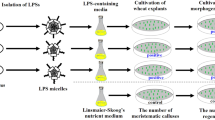Abstract
Callus induction of threefold cut mature embryos of one winter triticale (x Triticosecale Wittmack) variety (“Lasko”) and three spring triticale genotypes (PFT 8512, Ocepar 1 and PFT 8710) was determined in a recently developed aluminium (Al)-toxic medium. Callus weight and pH alteration of spent medium were assessed at the end of the callus induction phase of 7 weeks in media containing different levels of AlCl3 (0.1 – 10mM) and being sterilised either by filter or by autoclaving.
In filter-sterilised media with concentrations higher than 2mM none of the four examined triticale genotypes developed calli and the pH-level of the spent medium remained nearly constant. Lower concentrations of 0.5mM and 1mM Al yielded callus weights significantly higher than the pH 3.6-control without AI, but less than the pH 4.6-control, and pH increased on the same level as in either control. In all concentrations below 2mM Al, somatic embryos could be observed. In contrast, the toxic effect of autoclaved Al-toxic media was expressed by inferior callus quality - even the controls were poor - and did not result in any somatic embryo.
Consequently, filter-sterilised Al-toxic media should be preferred and could serve to select Al-tolerant cell lines, e.g. in suspension cell cultures, or may be useful to investigate Al-tolerance mechanisms at the celluar level.
Access this chapter
Tax calculation will be finalised at checkout
Purchases are for personal use only
Preview
Unable to display preview. Download preview PDF.
Similar content being viewed by others
References
Kinraide TB. Identity of the rhizotoxic aluminium species. In: Wright RJ, Baligar VC, Murrmann RP, editors. Plant-soil interactions at low pH. Dordrecht: Kluwer Academic Publishers, 1991: 717–28.
Wagatsuma T, Ezoe Y. Effect of pH on ionic species of aluminum in medium and on aluminum toxicity under solution culture. Soil Sci Plant Nutr 1985; 31: 547–61.
Conner AJ, Meredith CP. Stimulating the mineral environment of aluminium toxic soils in plant cell culture. J Exp Bot 1985; 36: 870–80.
Kamp-Glass M, Powell D, Reddy GB, Baligar VC, Wright RJ. Biotechniques for improving acid aluminum tolerance in alfalfa. Plant Cell Reports 1993; 12: 590–92.
Wersuhn G, Kalettka T, Gienapp R, Reinke G, Schulz D. Problems posed by in-vitro selection for aluminium-tolerance when using cultivated plant cells. J Plant Physiol 1994; 143: 92–95.
Potrykus I, Harms CT, Lörz H. Callus formation from cell culture protoplasts of corn (Zea mays L.). Theor Appl Genet 1979; 54: 209–14.
Murashige T, Skoog F. A revised medium for rapid growth and bio assays with tobacco tissue cultures. Physiol Plant 1962; 15: 473–97.
Ojima K, Koyama H, Suzuki R, Yamaya T. Characterization of two tobacco cell lines selected to grow in the presence of either ionic Al or insoluble Al-phosphate. Soil Sci Plant Nutr 1985; 35: 545–51.
Wersuhn G, Nhi HH, Tellhelm E, Börner T. Response of potato cell cultures to aluminium and selection of tolerant cell lines. Potato Research 1986; 29: 399–02.
Marziah M. Changes of pH of legume cell suspension culture media containing aluminium. In: Wright RI, Baligar VC, Murrmann RP, editors. Plant-soil interactions at low pH. Dordrecht: Kluwer Academic Publishers, 1991: 879–82.
Marziah M. Growth of peanut cells in suspension cultures treated with aluminium. In: Wright RI, Baligar VC, Murrmann RP, editors. Plant-soil interactions at low pH. Dordrecht: Kluwer Academic Publishers, 1991: 875–77.
Ojima K, Abe H, Ohira K. Release of citric acid into the medium by aluminum-tolerant carrot cells. Plant & Cell Physiol 1984; 25: 855–58.
Author information
Authors and Affiliations
Editor information
Editors and Affiliations
Rights and permissions
Copyright information
© 1996 Kluwer Academic Publishers
About this chapter
Cite this chapter
Gaus, C.S., Oettler, G., Hesemann, CU. (1996). Response of Mature Triticale Embryos to Aluminium-Toxic Callus Induction Media. In: Guedes-Pinto, H., Darvey, N., Carnide, V.P. (eds) Triticale: Today and Tomorrow. Developments in Plant Breeding, vol 5. Springer, Dordrecht. https://doi.org/10.1007/978-94-009-0329-6_47
Download citation
DOI: https://doi.org/10.1007/978-94-009-0329-6_47
Publisher Name: Springer, Dordrecht
Print ISBN: 978-94-010-6634-1
Online ISBN: 978-94-009-0329-6
eBook Packages: Springer Book Archive




